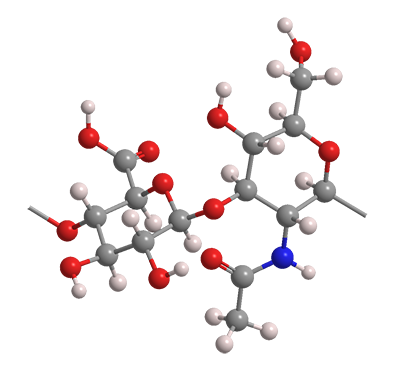What molecule am I?


According to the Merck Index, hyaluronic acid (HA; sometimes called hyaluronan) is “a natural high-viscosity mucopolysaccharide”. As shown in the images, it consists of repeating two-glucoside units. The molar mass of the natural material is between 106 and 107 g/cm3.
In the human body, highly viscous HA and its sodium salt are a major constituent of synovial fluid; they are also found in the vitreous humor and the umbilical cord. Its name is derived from hyalos, the Greek word for vitreous.
In 1934, Karl Meyer and John W. Palmer at Columbia University (New York) isolated HA from the vitreous humor of cattle eyes and measured many of its properties. Twenty years later, Meyer and Bernard Weissman described the structure of HA taken from umbilical cords.
HA-containing synovial fluid is a natural lubricant for the soft tissues that support natural or artificial joints such as hips and knees, helping them to function smoothly. HA scavenges radicals generated by inflammation. It is sometimes injected into arthritic joints to ease pain and assist movement.
HA is approved for use in some eye surgeries, but there is no evidence of its effectiveness in cosmetic anti-aging products. It can be used, however, as a dermal filler in the face to reduce wrinkles and provide fullness.
Hyaluronic acid hazard information
| GHS classification*: not a hazardous substance or mixture |
*Globally Harmonized System of Classification and Labeling of Chemicals.
MOTW update
Codeine was the Molecule of the Week for January 25, 2010. It is a widely used drug for treating coughs, pain, and irritable bowel syndrome. But it is a controlled substance, and, as such, it is difficult to import into the United Kingdom. TPI Enterprises, an Australian producer of poppy-based drugs, however, found a way. It struck a deal with British active ingredient producer Sterling Pharma Solutions to import TPI codeine from Norway and then convert it to its phosphate salt for sale to UK generic drug makers.
Hyaluronic acid fast facts
| CAS Reg. No. | 9004-61-9 |
| Molar mass | 3–7 x 106 g/mol |
| Empirical formula | (C14H21NO11)n |
| Appearance | Transparent, viscous fluid or white powder |
| Melting point | N/A |
| Water solubility | Infinite |
MOTW update
An eicosapentaenoic acid (EPA) isomer was the Molecule of the Week for September 30, 2013. It’s a fish oil–derived omega-3 fatty acid, which at that time was being synthesized by engineered bacteria. But there is now a method for producing it from another natural source: krill oil. During purification, EPA is converted to its ethyl ester and then restored to its free acid form.

Learn more about this molecule from CAS, the most authoritative and comprehensive source for chemical information.
Molecule of the Week needs your suggestions!
If your favorite molecule is not in our archive, please send us a message. The molecule can be notable for its current or historical importance or for any quirky reason. Thank you!
Stay Ahead of the Chemistry Curve
Learn how ACS can help you stay ahead in the world of chemistry.

